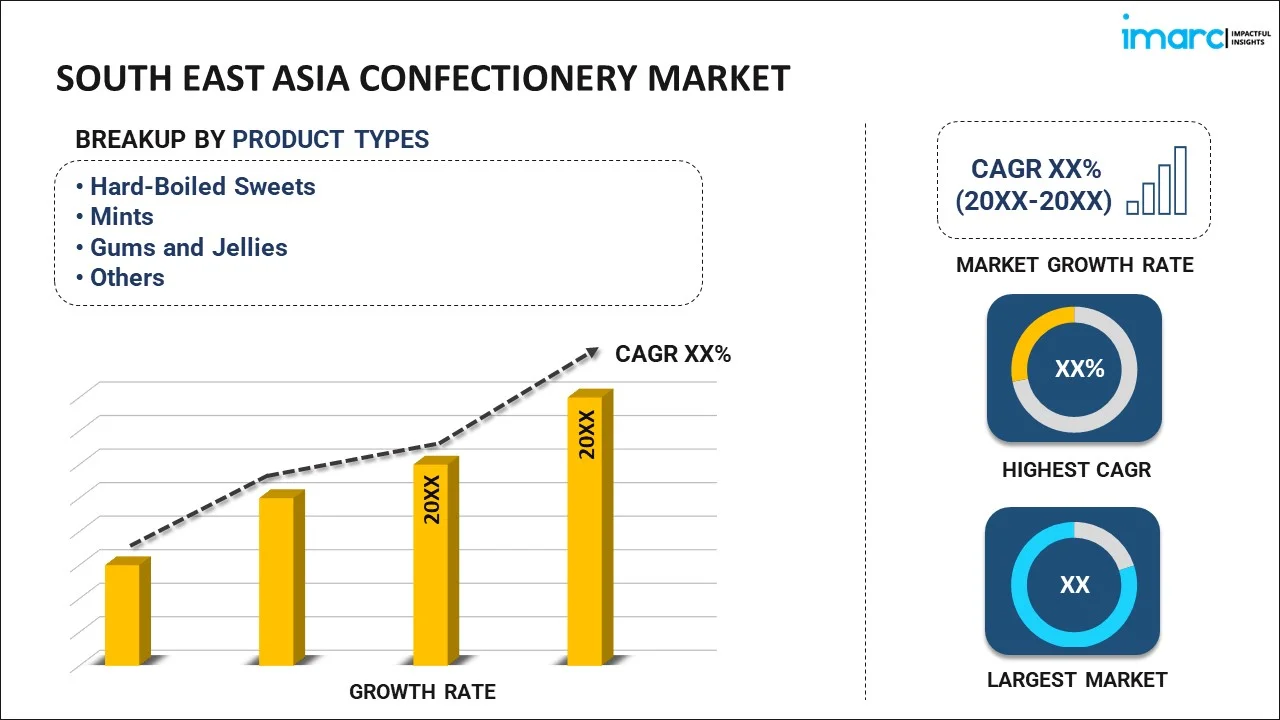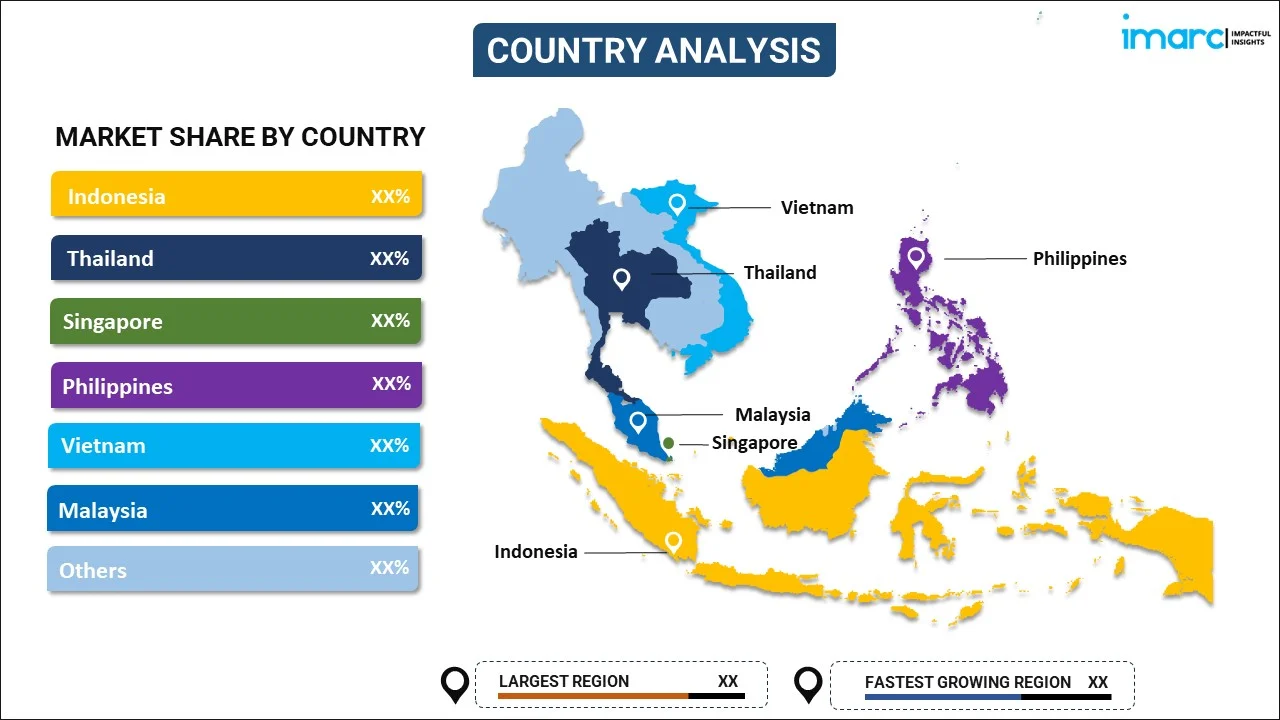IMARC made the whole process easy. Everyone I spoke with via email was polite, easy to deal with, kept their promises regarding delivery timelines and were solutions focused. From my first contact, I was grateful for the professionalism shown by the whole IMARC team. I recommend IMARC to all that need timely, affordable information and advice. My experience with IMARC was excellent and I can not fault it.
Read More
South East Asia Confectionery Market Report by Product Type (Hard-Boiled Sweets, Mints, Gums and Jellies, Chocolate, Caramels and Toffees, Medicated Confectionery, Fine Bakery Wares, and Others), Age Group (Children, Adult, Geriatric), Price Point (Economy, Mid-Range, Luxury), Distribution Channel (Supermarkets and Hypermarkets, Convenience Stores, Pharmaceutical and Drug Stores, Online Stores, and Others), and Country 2024-2032
Market Overview:
The South East Asia confectionery market size is projected to exhibit a growth rate (CAGR) of 8.44% during 2024-2032. The increasing disposable incomes of the masses, the rising trend of gifting chocolates during festivals and special occasions, rapid urbanization, and the effective marketing and branding strategies by confectionery companies represent some of the key factors driving the market.
|
Report Attribute
|
Key Statistics
|
|---|---|
|
Base Year
|
2023 |
|
Forecast Years
|
2024-2032 |
|
Historical Years
|
2018-2023
|
| Market Growth Rate (2024-2032) | 8.44% |
Confectionery refers to a category of food products that are primarily sweet in taste and often have a high sugar content. Confectionery items are typically enjoyed as snacks, desserts, or treats and come in various forms, textures, and flavors. They are made from a combination of ingredients, including sugar or sweeteners, flavorings, and often fats, such as chocolate or butter. Confectionery encompasses a wide range of sweet foods such as candies that come in various forms, including hard candies, soft candies, gummies, and chewy candies. Popular examples include chocolate bars, lollipops, gumdrops, and jellybeans. Moreover, chocolate is a widely loved confectionery product made from cocoa beans. It can be found in various forms, such as chocolate bars, truffles, bonbons, and chocolate-covered fruits or nuts. Dark chocolate, milk chocolate, and white chocolate are some common varieties. Confectionery is enjoyed in various forms and on different occasions, from casual snacking to special celebrations like birthdays, holidays, and weddings. It is produced by confectionery manufacturers and is widely available in stores, supermarkets, and specialty shops, making it a beloved and accessible treat for many people around the world.
South East Asia Confectionery Market Trends:
Increasing disposable income levels in South East Asia have led to higher consumer spending on indulgent and premium confectionery items. As people have more purchasing power, they are more inclined to treat themselves to sweets and luxury confections. In addition, rapid urbanization in the region is driving changes in lifestyle and consumer preferences. Urban populations often have greater access to a variety of confectionery products, and convenience stores, supermarkets, and online retailers are expanding the distribution of these items. Besides, gifting confectionery items, especially during festivals, holidays, and special occasions, is a common tradition in many South East Asian countries. This cultural practice drives seasonal spikes in confectionery sales. Moreover, the growth of e-commerce platforms has made it easier for consumers to access a wide variety of confectionery products. Online retailers offer convenience, a wide product selection, and the ability to purchase confections from around the world. Additionally, confectionery manufacturers are introducing innovative products, flavors, and packaging to cater to changing consumer preferences. Unique and exotic flavors, as well as health-conscious options, are gaining popularity. Furthermore, effective marketing and branding strategies by confectionery companies have increased brand visibility and consumer awareness. Promotions, endorsements, and creative advertising campaigns play a crucial role in driving sales. On account of these factors, the market is expected to witness positive growth in the coming years.
South East Asia Confectionery Market Segmentation:
IMARC Group provides an analysis of the key trends in each segment of the market, along with forecasts at the regional and country levels for 2024-2032. Our report has categorized the market based on product type, age group, price point, and distribution channel.
Product Type Insights:

- Hard-boiled Sweets
- Mints
- Gums and Jellies
- Chocolate
- Caramels and Toffees
- Medicated Confectionery
- Fine Bakery Wares
- Others
The report has provided a detailed breakup and analysis of the market based on the product type. This includes hard-boiled sweets, mints, gums and jellies, chocolate, caramels and toffees, medicated confectionery, fine bakery wares, and others.
Age Group Insights:
- Children
- Adult
- Geriatric
A detailed breakup and analysis of the market based on the age group have also been provided in the report. This includes children, adult, and geriatric.
Price Point Insights:
- Economy
- Mid-range
- Luxury
The report has provided a detailed breakup and analysis of the market based on the price point. This includes economy, mid-range, and luxury.
Distribution Channel Insights:
- Supermarkets and Hypermarkets
- Convenience Stores
- Pharmaceutical and Drug Stores
- Online Stores
- Others
A detailed breakup and analysis of the market based on the distribution channel have also been provided in the report. This includes supermarkets and hypermarkets, convenience stores, pharmaceutical and drug stores, online stores, and others.
Country Insights:

- Indonesia
- Thailand
- Singapore
- Philippines
- Vietnam
- Malaysia
- Others
The report has also provided a comprehensive analysis of all the major regional markets, which include Indonesia, Thailand, Singapore, Philippines, Vietnam, Malaysia, and Others.
Competitive Landscape:
The market research report has also provided a comprehensive analysis of the competitive landscape in the market. Competitive analysis such as market structure, key player positioning, top winning strategies, competitive dashboard, and company evaluation quadrant has been covered in the report. Also, detailed profiles of all major companies have been provided.
South East Asia Confectionery Market Report Coverage:
| Report Features | Details |
|---|---|
| Base Year of the Analysis | 2023 |
| Historical Period | 2018-2023 |
| Forecast Period | 2024-2032 |
| Units | US$ Million |
| Scope of the Report | Exploration of Historical Trends and Market Outlook, Industry Catalysts and Challenges, Segment-Wise Historical and Future Market Assessment:
|
| Product Types Covered | Hard-Boiled Sweets, Mints, Gums and Jellies, Chocolate, Caramels and Toffees, Medicated Confectionery, Fine Bakery Wares, Others |
| Age Groups Covered | Children, Adult, Geriatric |
| Price Points Covered | Economy, Mid-Range, Luxury |
| Distribution Channels Covered | Supermarkets and Hypermarkets, Convenience Stores, Pharmaceutical and Drug Stores, Online Stores, Others |
| Countries Covered | Indonesia, Thailand, Singapore, Philippines, Vietnam, Malaysia, Others |
| Customization Scope | 10% Free Customization |
| Report Price and Purchase Option | Single User License: US$ 3699 Five User License: US$ 4699 Corporate License: US$ 5699 |
| Post-Sale Analyst Support | 10-12 Weeks |
| Delivery Format | PDF and Excel through Email (We can also provide the editable version of the report in PPT/Word format on special request) |
Key Questions Answered in This Report:
- How has the South East Asia confectionery market performed so far and how will it perform in the coming years?
- What has been the impact of COVID-19 on the South East Asia confectionery market?
- What is the breakup of the South East Asia confectionery market on the basis of product type?
- What is the breakup of the South East Asia confectionery market on the basis of age group?
- What is the breakup of the South East Asia confectionery market on the basis of price point?
- What is the breakup of the South East Asia confectionery market on the basis of distribution channel?
- What are the various stages in the value chain of the South East Asia confectionery market?
- What are the key driving factors and challenges in the South East Asia confectionery?
- What is the structure of the South East Asia confectionery market and who are the key players?
- What is the degree of competition in the South East Asia confectionery market?
Key Benefits for Stakeholders:
- IMARC’s industry report offers a comprehensive quantitative analysis of various market segments, historical and current market trends, market forecasts, and dynamics of the South East Asia confectionery market from 2018-2032.
- The research report provides the latest information on the market drivers, challenges, and opportunities in the South East Asia confectionery market.
- Porter's five forces analysis assist stakeholders in assessing the impact of new entrants, competitive rivalry, supplier power, buyer power, and the threat of substitution. It helps stakeholders to analyze the level of competition within the South East Asia confectionery industry and its attractiveness.
- Competitive landscape allows stakeholders to understand their competitive environment and provides an insight into the current positions of key players in the market.
Need more help?
- Speak to our experienced analysts for insights on the current market scenarios.
- Include additional segments and countries to customize the report as per your requirement.
- Gain an unparalleled competitive advantage in your domain by understanding how to utilize the report and positively impacting your operations and revenue.
- For further assistance, please connect with our analysts.

Purchase Options
Benefits of Customization
Personalize this research
Triangulate with your data
Get data as per your format and definition
Gain a deeper dive into a specific application, geography, customer, or competitor
Any level of personalization
Get in Touch With Us
UNITED STATES
Phone: +1-631-791-1145
INDIA
Phone: +91-120-433-0800
UNITED KINGDOM
Phone: +44-753-714-6104
Email: sales@imarcgroup.com
 Inquire Before Buying
Inquire Before Buying Speak to an Analyst
Speak to an Analyst  Request Brochure
Request Brochure  Request Customization
Request Customization



.webp)




.webp)












